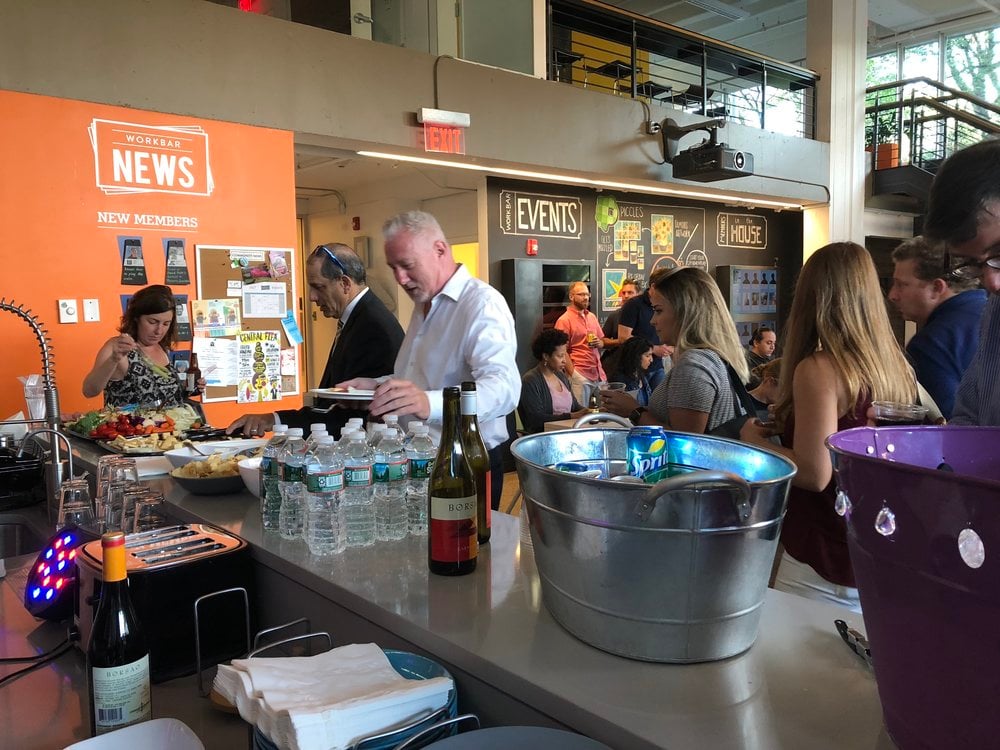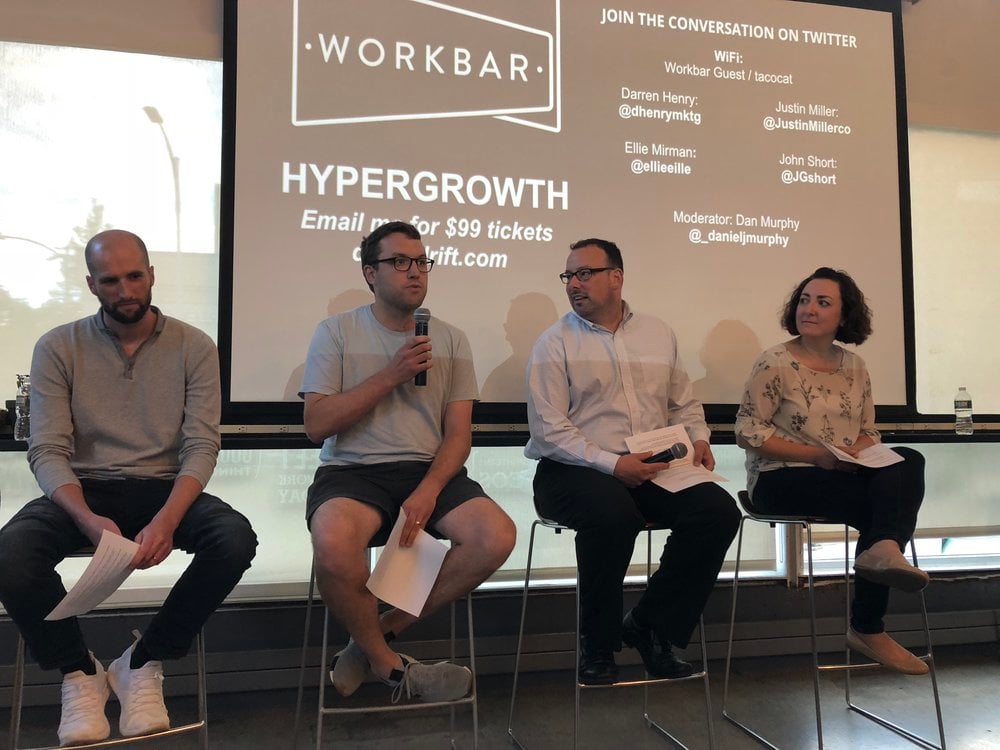Boston’s Top Marketing Pros Share Organic Demand Generation Best Practices During Drift and Workbar Speaker Panel



















Four of Boston’s top marketers shared their take on growing the organic presence of their company and generating leads on a budget during Workbar and Drift's marketing panel on July 26.
Marketing, more so than many other fields in business, has evolved significantly in the recent years. With a growing set of new digital tools accessible to virtually anyone, it’s becoming easier and easier for people to use paid channels to promote products and services. But, should that be the core muscle of a business’s marketing plan?
This very topic was at the center of the discussion during Drift and Workbar’s panel “Cost-Effective Demand Generation”, held at the Cambridge coworking space. During the event, four of Boston’s top B2B and B2C marketers shared their take on growing the organic presence of their company, generating leads on a budget and combining paid and organic channels to develop brand awareness.
75+ Marketers in the House
More than 75 marketing pros and business leaders gathered at Workbar for the panel moderated by Drift’s Daniel Murphy and featuring Ellie Mirman, CMO at Crayon, Darren Henry, VP of Marketing at OpsGenie, Justin Miller, Head of Marketing at Workbar and John Short, Founder of Compound Growth Agency.
Coming from different backgrounds and having worked for large and small companies with diverse marketing needs, the panelists shared what has and hasn’t worked for them when it comes to demand generation and nurturing relations with prospective clients.
In order to build an efficient and sustainable strategy, these marketing pros maintain companies cannot only restore to using paid channels – it’s been proven that to generate high-quality leads that convert quickly, it is key to develop organic marketing practices.

Combining Organic and Paid Channels for the Win
At Crayon, OpsGenie, Workbar and Compound Growth agency, the panelists have grown their team’s leads in a short time, and while their budget and goals vary, all four of them have developed strategies that put a combination of paid and organic marketing at the center of the stage.
Devoting time and resources to keyword research and building a solid foundation of SEO-friendly content that drives traffic and brand awareness has been the main marketing pillar for companies where Short and Henry have worked. However, combining those efforts with some paid channels has proven to be the most efficient move.
“If you make a good investment in creating quality content, that content can drive traffic to your site for years to come.”
“We are content strong [at OpsGenie]. I believe that is the most important part of our marketing plan. We have great people working to develop content, but we also focus on other paid marketing”
“Click-through rates, conversation rates are impacted by your brand awareness and recognition. And the quality of your content is what determines that. You cannot build a successful strategy with only Adwords. Other channels are really valuable for demand generation”
It is not an unknown fact that focusing on creating high quality content on topics relevant to the business has helped companies become an authority in their industry and subsequently drive sales and grow revenue. Yet the power of content is sometimes diminished by the need to compete with larger, more established and wealthier companies.
“Adwords is really important for us, since we are fishing in a pond with bigger fish. What people are searching is really important for Workbar because we know these days people can really make a transactional decision based on what they find on an online search.”
“You cannot be dependent on organic [marketing practices]. There are so many different marketing aspects and you can learn so much from paid channels. You can’t solve everything with content.You can do a lot with content, but you can’t lose sight of the overall goal of creating that content, which is leading traffic into the sales funnel”

New Marketing Technologies To Facilitate The Process
If using a combination of organic and paid marketing strategies to drive leads is the recommended way to go, then using a variety of tools to implement those strategy is also a smart move, right? Well, according to our panelists and pros, it absolutely depends on the industry and campaign that will be executed.
For Mirman, who was part of Hubspot’s original marketing team (when the company had under 10 employees), marketers shouldn’t get caught in the process and focus more on the idea; the tools they use should only facilitate implementation.
“The conversation shouldn’t be about so much about the marketing technology, it should be about making it easy for you to run the campaigns you want to run, do the tests you need to do. In that aspect, I’ve usually returned to the tools I know, like Hubspot.”
For Miller, who heads a small marketing team at Workbar, using multiple simple tools has helped him fulfill many marketing needs while also obtaining information from potential customers – a particular tool has been useful for this: Drift.
“Using Drift from a marketing standpoint has been really eye-opening. Other than getting people in for tours [of Workbar], we get questions about our website, we get to learn what keywords people are using. Knowing those things have helped us improve. That one-on-one connection with your target demographic is super helpful.”
Because many of the most popular marketing tools also come with a big price tag, marketers should analyse the return on investment before committing to a new technology that might not be an immediate necessity or might not be suitable for their industry.
“From a leadership perspective, you need to do an inventory of the tools you are using and the money you spending on those and rethink what is useful and what is bringing you results”
Figuring out What Works and WHY it Works
Regardless of their marketing technology of choice, for Mirman, marketers must focus on analyzing the results of every campaign they do frequently and early on to determine which strategies are bringing in results.
She warns that while it might be easier to create a mold-process and replicate everything that has proven successful, a more analytical approach is critical. No because a tool or a campaign worked once, it will over again for years to come.
“If you find something that works, figure out WHAT works about it. That’s the key. Don’t throw it away by overusing it when it stops performing.”
“I’m a big believer in having every single person on the team have access to data analytics. You must be able to connect the dots between the metrics and the goals of the team and the company.”
The Relationship Between Sales and Marketing
For many marketers, fostering a healthy and collaborative relationship with sales departments has proven challenging.
Competition, disconnection, confusion regarding best practices, egos, and more can get in the way and create a hostile environment. Yet, working closely and symbiotically with sales is crucial to building a marketing plan that delivers.
“As a marketer, there’s a lot of creativity that can come from talking to your sales team constantly. They are the ones talking to leads, you can get great campaign ideas that work for your target demographic from them.”
Just like talking to your peers in sales can lead to the next creative break, ignoring their advice or keeping the communication to a minimum can have really negative effects for a business.
“I don’t think you should allow any tension between sales and marketing. My advice for maintaining a healthy relationship: meet often, align in goals and have meaningful connections and conversations.”
“I’ve turned down jobs because I’ve gotten a bad vibe from the VP of Sales. A bad relationship between leadership in sales and leadership in marketing then trickles down to every level of the company”
With an array of tools available in the marketing world and with the constant changes in technology and strategy, focusing on cost-effective generation demand has become crucial for businesses with budgets of all sizes.
While no one has all the answers when it comes to driving qualified leads and traffic, having access to data, evaluating the strategy early and often and figuring what campaigns are working and why they’re working can help marketers grow demand without breaking the bank, and most importantly – learn and improve along the way.
Workbar Speaker Series is a monthly event that connects local innovators and leaders in the Boston community and offers an interactive space for discussion, conversation and networking. With different topics and speakers each session, the event looks inspire attendees with insightful contributions and to create a positive footprint in the innovation scene.


